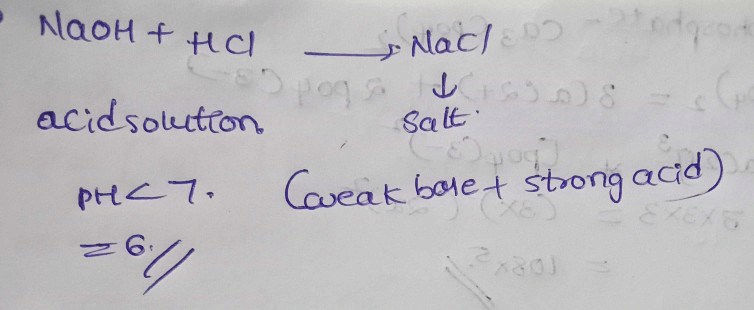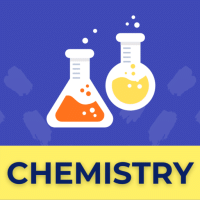Class 11 Exam > Class 11 Questions > The≈ pH of the neutralisation point of ...
Start Learning for Free
The ≈ pH of the neutralisation point of 0.1 N ammonium hydroxide with 0.1 N HCl is
- a)1
- b)6
- c)7
- d)9
Correct answer is option 'B'. Can you explain this answer?
Verified Answer
The≈ pH of the neutralisation point of 0.1 N ammonium hydroxide ...
Salt formed : NH4Cl = 0.1 N
Solution will be slightly acidic due to Hydrolysis
Solution will be slightly acidic due to Hydrolysis
Most Upvoted Answer
The≈ pH of the neutralisation point of 0.1 N ammonium hydroxide ...

Free Test
FREE
| Start Free Test |
Community Answer
The≈ pH of the neutralisation point of 0.1 N ammonium hydroxide ...
The pH of the neutralization point of 0.1 N ammonium hydroxide with 0.1 N HCl is 6.
Explanation:
1. Neutralization reaction: Ammonium hydroxide (NH4OH) is a weak base, and hydrochloric acid (HCl) is a strong acid. When these two substances react, they undergo a neutralization reaction to form water (H2O) and ammonium chloride (NH4Cl).
NH4OH + HCl -> NH4Cl + H2O
2. Ammonium hydroxide dissociation: Ammonium hydroxide partially dissociates in water to form ammonium ions (NH4+) and hydroxide ions (OH-).
NH4OH -> NH4+ + OH-
3. Hydrochloric acid dissociation: Hydrochloric acid dissociates completely in water to form hydronium ions (H3O+) and chloride ions (Cl-).
HCl -> H3O+ + Cl-
4. Formation of ammonium chloride: In the neutralization reaction, the ammonium ions (NH4+) from ammonium hydroxide combine with the chloride ions (Cl-) from hydrochloric acid to form ammonium chloride (NH4Cl). There are no remaining hydroxide or hydronium ions in the solution.
NH4+ + Cl- -> NH4Cl
5. pH of the neutralization point: Since ammonium chloride is a salt, it dissociates completely in water. The resulting solution contains equal concentrations of ammonium ions (NH4+) and chloride ions (Cl-), which do not affect the pH significantly. Therefore, the pH of the neutralization point is determined by the remaining water and any excess hydronium ions (H3O+) or hydroxide ions (OH-) in the solution.
6. In this case, since ammonium hydroxide is a weak base and hydrochloric acid is a strong acid, the resulting solution will have an excess of hydronium ions (H3O+). The pH of a solution is defined as the negative logarithm of the hydronium ion concentration. A high concentration of hydronium ions corresponds to a low pH value.
7. As the concentrations of ammonium hydroxide and hydrochloric acid are both 0.1 N, they react in a 1:1 ratio. Therefore, the concentration of hydronium ions in the resulting solution will also be 0.1 N.
8. The pH of a 0.1 N hydronium ion solution is 1, which indicates that the solution is highly acidic.
9. Thus, the correct answer is option B, pH 6, as the pH of the neutralization point is determined by the excess hydronium ions from the hydrochloric acid.
Explanation:
1. Neutralization reaction: Ammonium hydroxide (NH4OH) is a weak base, and hydrochloric acid (HCl) is a strong acid. When these two substances react, they undergo a neutralization reaction to form water (H2O) and ammonium chloride (NH4Cl).
NH4OH + HCl -> NH4Cl + H2O
2. Ammonium hydroxide dissociation: Ammonium hydroxide partially dissociates in water to form ammonium ions (NH4+) and hydroxide ions (OH-).
NH4OH -> NH4+ + OH-
3. Hydrochloric acid dissociation: Hydrochloric acid dissociates completely in water to form hydronium ions (H3O+) and chloride ions (Cl-).
HCl -> H3O+ + Cl-
4. Formation of ammonium chloride: In the neutralization reaction, the ammonium ions (NH4+) from ammonium hydroxide combine with the chloride ions (Cl-) from hydrochloric acid to form ammonium chloride (NH4Cl). There are no remaining hydroxide or hydronium ions in the solution.
NH4+ + Cl- -> NH4Cl
5. pH of the neutralization point: Since ammonium chloride is a salt, it dissociates completely in water. The resulting solution contains equal concentrations of ammonium ions (NH4+) and chloride ions (Cl-), which do not affect the pH significantly. Therefore, the pH of the neutralization point is determined by the remaining water and any excess hydronium ions (H3O+) or hydroxide ions (OH-) in the solution.
6. In this case, since ammonium hydroxide is a weak base and hydrochloric acid is a strong acid, the resulting solution will have an excess of hydronium ions (H3O+). The pH of a solution is defined as the negative logarithm of the hydronium ion concentration. A high concentration of hydronium ions corresponds to a low pH value.
7. As the concentrations of ammonium hydroxide and hydrochloric acid are both 0.1 N, they react in a 1:1 ratio. Therefore, the concentration of hydronium ions in the resulting solution will also be 0.1 N.
8. The pH of a 0.1 N hydronium ion solution is 1, which indicates that the solution is highly acidic.
9. Thus, the correct answer is option B, pH 6, as the pH of the neutralization point is determined by the excess hydronium ions from the hydrochloric acid.

|
Explore Courses for Class 11 exam
|

|
Question Description
The≈ pH of the neutralisation point of 0.1 N ammonium hydroxide with 0.1 N HCl isa)1b)6c)7d)9Correct answer is option 'B'. Can you explain this answer? for Class 11 2025 is part of Class 11 preparation. The Question and answers have been prepared according to the Class 11 exam syllabus. Information about The≈ pH of the neutralisation point of 0.1 N ammonium hydroxide with 0.1 N HCl isa)1b)6c)7d)9Correct answer is option 'B'. Can you explain this answer? covers all topics & solutions for Class 11 2025 Exam. Find important definitions, questions, meanings, examples, exercises and tests below for The≈ pH of the neutralisation point of 0.1 N ammonium hydroxide with 0.1 N HCl isa)1b)6c)7d)9Correct answer is option 'B'. Can you explain this answer?.
The≈ pH of the neutralisation point of 0.1 N ammonium hydroxide with 0.1 N HCl isa)1b)6c)7d)9Correct answer is option 'B'. Can you explain this answer? for Class 11 2025 is part of Class 11 preparation. The Question and answers have been prepared according to the Class 11 exam syllabus. Information about The≈ pH of the neutralisation point of 0.1 N ammonium hydroxide with 0.1 N HCl isa)1b)6c)7d)9Correct answer is option 'B'. Can you explain this answer? covers all topics & solutions for Class 11 2025 Exam. Find important definitions, questions, meanings, examples, exercises and tests below for The≈ pH of the neutralisation point of 0.1 N ammonium hydroxide with 0.1 N HCl isa)1b)6c)7d)9Correct answer is option 'B'. Can you explain this answer?.
Solutions for The≈ pH of the neutralisation point of 0.1 N ammonium hydroxide with 0.1 N HCl isa)1b)6c)7d)9Correct answer is option 'B'. Can you explain this answer? in English & in Hindi are available as part of our courses for Class 11.
Download more important topics, notes, lectures and mock test series for Class 11 Exam by signing up for free.
Here you can find the meaning of The≈ pH of the neutralisation point of 0.1 N ammonium hydroxide with 0.1 N HCl isa)1b)6c)7d)9Correct answer is option 'B'. Can you explain this answer? defined & explained in the simplest way possible. Besides giving the explanation of
The≈ pH of the neutralisation point of 0.1 N ammonium hydroxide with 0.1 N HCl isa)1b)6c)7d)9Correct answer is option 'B'. Can you explain this answer?, a detailed solution for The≈ pH of the neutralisation point of 0.1 N ammonium hydroxide with 0.1 N HCl isa)1b)6c)7d)9Correct answer is option 'B'. Can you explain this answer? has been provided alongside types of The≈ pH of the neutralisation point of 0.1 N ammonium hydroxide with 0.1 N HCl isa)1b)6c)7d)9Correct answer is option 'B'. Can you explain this answer? theory, EduRev gives you an
ample number of questions to practice The≈ pH of the neutralisation point of 0.1 N ammonium hydroxide with 0.1 N HCl isa)1b)6c)7d)9Correct answer is option 'B'. Can you explain this answer? tests, examples and also practice Class 11 tests.

|
Explore Courses for Class 11 exam
|

|
Signup for Free!
Signup to see your scores go up within 7 days! Learn & Practice with 1000+ FREE Notes, Videos & Tests.


















